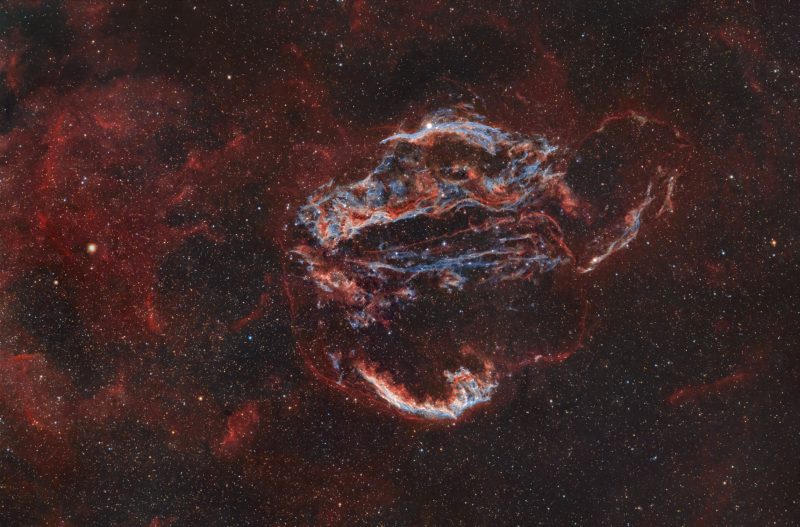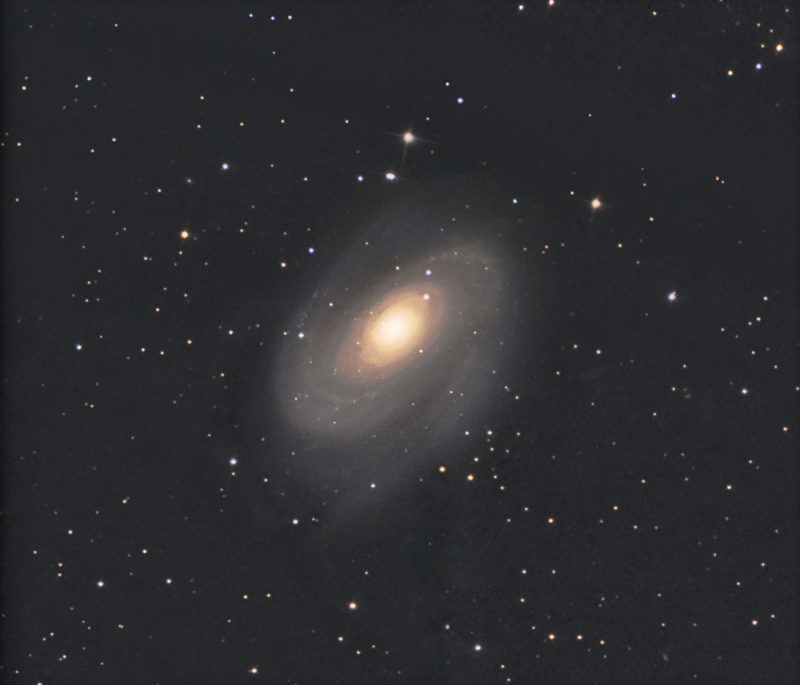
September deep sky photos
Explore the depths of September’s deep sky with these amazing photos taken by two photographers and friends of EarthSky.
The Cygnus Loop
The Cygnus Loop is a large supernova remnant stretching from the constellation Cygnus the Swan into neighboring Vulpecula the Fox. Portions of the Cygnus Loop are also called the Veil Nebula. The Cygnus Loop lies approximately 2,600 light-years from Earth. The bright tendrils and dusty filaments span 130 light-years in diameter, stretching three degrees across. A span of three degrees would look like the width of six full moons on the dome of our sky. The nebula is about 21,000 years old. As yet, scientists have been unable to find the stellar remnant that caused the supernova explosion.
Bode’s Galaxy
Bode’s Galaxy, or M81 (Messier 81), lies in Ursa Major, to the upper right of the Big Dipper’s Bowl on September evenings. This majestic face-on spiral galaxy is close enough to Polaris, the North Star, that you can technically hunt down this deep-sky object on any night of the year from northern latitudes. Bode’s Galaxy shines at magnitude 6.9, making it a decent target for binoculars. If you go out galaxy hunting for M81, you’ll be rewarded with a bonus galaxy nearby, M82, an edge-on spiral shining at magnitude 8.4.

Bottom line: EarthSky readers shared two amazing deep-sky photographs with us: the Cygnus Loop and Bode’s Galaxy, both good observing targets for September.
The post September deep sky: Cygnus Loop and Bode’s Galaxy first appeared on EarthSky.
from EarthSky https://ift.tt/3AJlRlu

September deep sky photos
Explore the depths of September’s deep sky with these amazing photos taken by two photographers and friends of EarthSky.
The Cygnus Loop
The Cygnus Loop is a large supernova remnant stretching from the constellation Cygnus the Swan into neighboring Vulpecula the Fox. Portions of the Cygnus Loop are also called the Veil Nebula. The Cygnus Loop lies approximately 2,600 light-years from Earth. The bright tendrils and dusty filaments span 130 light-years in diameter, stretching three degrees across. A span of three degrees would look like the width of six full moons on the dome of our sky. The nebula is about 21,000 years old. As yet, scientists have been unable to find the stellar remnant that caused the supernova explosion.
Bode’s Galaxy
Bode’s Galaxy, or M81 (Messier 81), lies in Ursa Major, to the upper right of the Big Dipper’s Bowl on September evenings. This majestic face-on spiral galaxy is close enough to Polaris, the North Star, that you can technically hunt down this deep-sky object on any night of the year from northern latitudes. Bode’s Galaxy shines at magnitude 6.9, making it a decent target for binoculars. If you go out galaxy hunting for M81, you’ll be rewarded with a bonus galaxy nearby, M82, an edge-on spiral shining at magnitude 8.4.

Bottom line: EarthSky readers shared two amazing deep-sky photographs with us: the Cygnus Loop and Bode’s Galaxy, both good observing targets for September.
The post September deep sky: Cygnus Loop and Bode’s Galaxy first appeared on EarthSky.
from EarthSky https://ift.tt/3AJlRlu

Aucun commentaire:
Enregistrer un commentaire